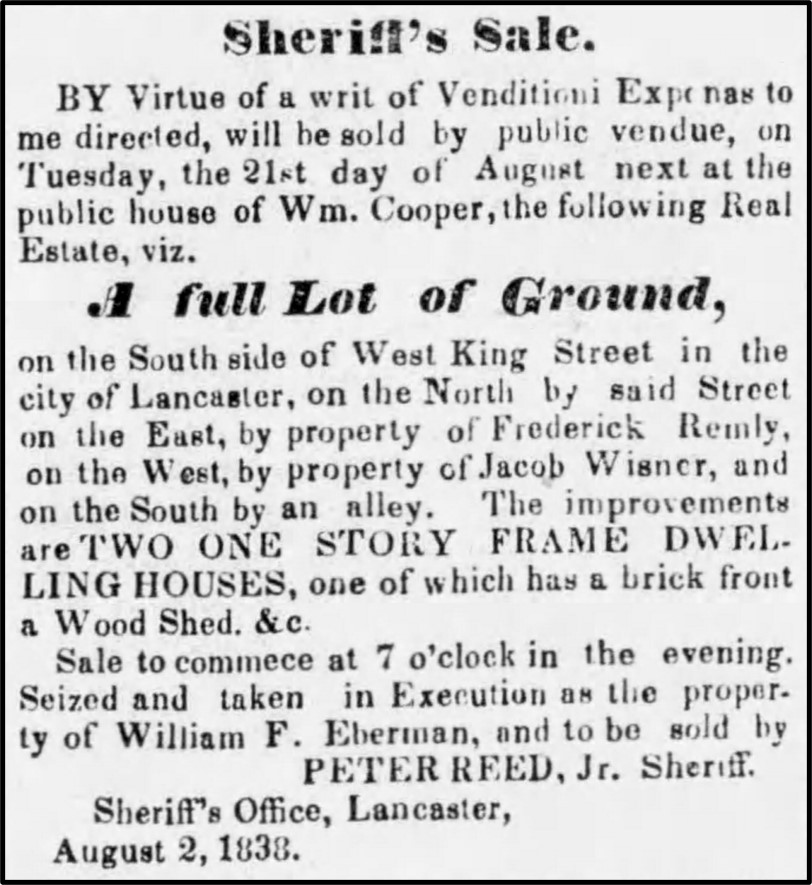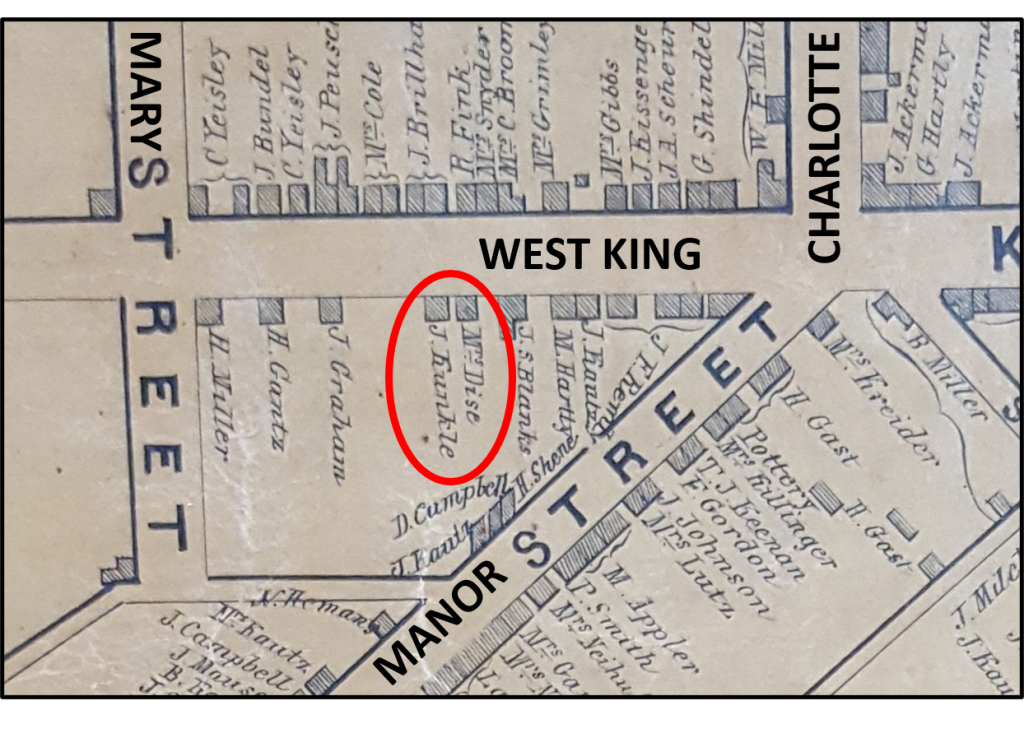Jim Gerhart, December 2020
One of the better-preserved one-story houses in Lancaster is the blue house with the red door at 434 West King Street. This four-bay, center-chimney, Germanic-style house is typical of the many hundreds of such houses, also sometimes known as one-and-a-half-story houses, that once dominated the architecture of the city during the Federal period of the late eighteenth and early nineteenth centuries. The 550-square-foot house is located on the very northern edge of the SoWe project area, less than a block outside of Cabbage Hill.

How old is the house? Who built it? Who owned it over the years? There is not much information available to answer these questions, and what little exists is somewhat contradictory. Real-estate websites date the house as early as the 1790s and as late as 1880. A 1985 survey by the Historic Preservation Trust and a 1995 report by the City of Lancaster both refer to the property as the Geise House and date it to about 1840. But an old map and tax records show that a Barbara Geiss owned the house next door instead. To try to resolve these conflicts and answer the questions above, extensive research into historic deed, tax, directory, newspaper, and other sources was undertaken.
The result of that research indicates that 434 West King has an interesting and fairly complicated history. Construction of this venerable old one-story frame house probably was completed in 1817. The lot where the house is located was originally 64 feet wide along the south side of West King and 245 feet deep to what would eventually become Campbell Alley. The house’s early history is closely tied to the Eberman family, a prominent family in Lancaster in the late 1700s.
John Eberman III (1776-1846) probably began building the house at 434 in late 1816. John III, a cashier and bank treasurer, was the son of John Eberman, Jr. (1749-1835), a famous clockmaker whose clocks are highly valued today. John, Jr. also was a prominent Lancaster citizen who served as Chief Burgess and Justice of the Peace, and as a sergeant in the Revolutionary War. John, Jr. made and installed the four-dial clock in the steeple of the second courthouse in the square about 1785. John, Jr.’s father, John Eberman, Sr. (1722-1805), was a soap boiler and tallow chandler who immigrated to Lancaster from Germany in the mid-1740s. The Ebermans were a prolific family: John, Sr. had 12 children, John, Jr. 13, and John III 10.

Several members of the extended Eberman family owned 434 from 1816 to 1838. Before John III had even completed the house, his first tenant moved in. Tax records show that John III rented the house “unfinished to P. Shugar’s” in 1817. (Presumably John III and/or Shugar completed the house shortly thereafter.) Peter Shugar was related to John III through marriage; he had married John III’s aunt, Elizabeth Eberman, in 1796. Upon marrying into the Eberman family, Shugar took over the aging John, Sr.’s soap and chandler business. The Shugars had six children.
Unfortunately, Peter Shugar, whose surname was later anglicized to Schucker, died a couple years after moving into 434. Immediately after Peter’s death, his wife Elizabeth bought the house, which was valued at $250, from her nephew, John III. A few years later, in 1823 or 1824, Elizabeth divided the lot into two, keeping 434 on the western half of the lot for herself and selling the vacant eastern half of the lot back to her nephew, John III. By 1829, John III had built a one-story frame house on the eastern half of the lot, the house number for which would eventually be 430. (This house, which had a brick front and was a little larger than 434, was torn down around 1900 and replaced with the three-story building that now stands to the east of 434.)
In 1830 or 1831, the ownership of 434 became more complicated. Elizabeth Shugar sold the house to Jacob Eberman, a shoemaker who was Elizabeth’s nephew, the son of her older brother Philip. Jacob was also Elizabeth’s son-in-law. He had married his first cousin, Peter and Elizabeth’s daughter Sarah Shugar, in 1824. Jacob’s ownership of 434 did not last very long. By 1832, Jacob and Sarah and their children had moved to Wooster, Ohio, selling 434 to Jacob’s cousin William Eberman, the son of John, Jr., the clockmaker, and the younger brother of John III. (Jacob and Sarah would return to Lancaster about a year later, and live in a one-story house on West King across from 434.) William Eberman, who bought 434 from Jacob, was a tinsmith and an innkeeper. William also bought the house at 430 at the same time.

William Eberman owned 434 and 430 until 1838 when he apparently ran into financial trouble and was forced to sell the two houses to pay off his debts. Dr. Charles Herbst, a pharmacist, bought both houses at a public sale in September 1838. In a newspaper advertisement for the sale, the houses were described as “two one story frame dwelling houses, one of which has a brick front a wood shed etc.” on a “full lot of ground on the south side of West King Street.”
Charles Herbst sold both houses on April 1, 1840. The house at 430 was sold to Barbara Geiss, a widow with a young son, for $475. The house at 434 was sold for $425 to Margaret Gantz, a widow who had two children. At about the same time widow Gantz bought 434, she remarried, to Joseph Kunkle. Joseph Kunkle was a peddler, and he and Margaret had four more children together over the next decade.

Joseph Kunkle died in the mid-1860s. His wife Margaret continued living in 434 until her death in 1890. Margaret’s will stipulated that her daughters Mary and Rose were to continue to live in 434 as long as they wished. The two sisters lived there following Margaret’s death for five years until Rose came down from the attic level one day to discover her sister Mary dead in the summer kitchen.
Rose Kunkle continued living in 434 until she married Leo Myers in 1909 and moved with him to St. Joseph Street, where Leo ran a grocery store. (Leo Myers’ grocery was located in the recently-painted light green house on the corner of Filbert and St. Joseph Streets, with “Welcome to Cabbage Hill” painted on its side.) When Leo died in 1913, Rose moved back to 434, living there alone until her death in 1929.
After Rose’s death, the administrator for Margaret Kunkle’s estate sold the house at public sale to Sarah and Jack Winkoff, who paid $4,380 for the house and half lot. An advertisement for the public sale stated that the “Lot fronts 33 feet on the south side of West King street…” and “The improvements consist of a 1 ½ story frame house, with six rooms.”
The Minkoffs rented out 434 until 1965, when they sold it to Ronald Cook, who lived there until 1973, when he sold it to Carol Miller, who lived there into the 1980s. The current owner is David Aviles Morales, who has maintained it without changing its basic historical appearance. The house is now available for booking as an Airbnb rental.
So, to answer the earlier questions: 434 West King was built about 1817 by John Eberman III. For a 203-year-old house, it has not had very many owners, with the Eberman, Kunkle, and Minkoff families accounting for nearly 150 of those years. A good name for the house might be the Eberman-Kunkle House, in honor of its builder and the family that owned it the longest.
As a survivor from an earlier time in Lancaster’s history, 434 West King reminds us of what much of Lancaster used to look like. Hopefully, it will continue to have owners dedicated to its preservation, and serve as a reminder of our history for many years to come.
